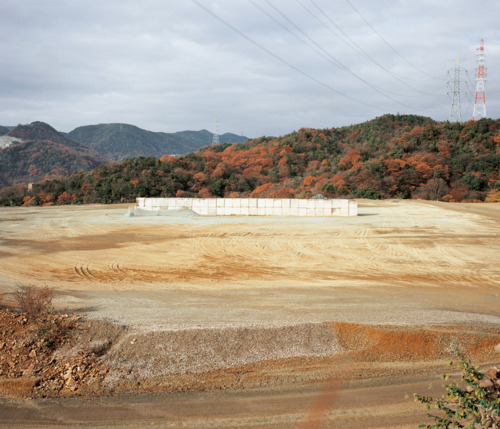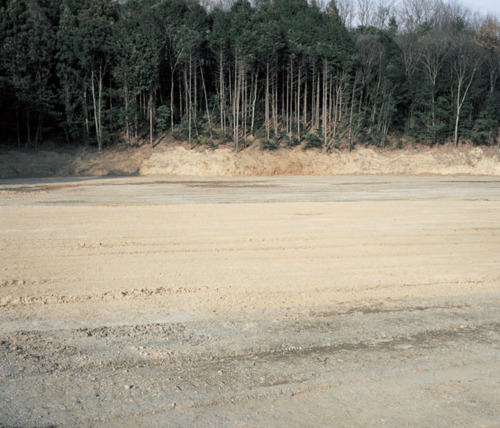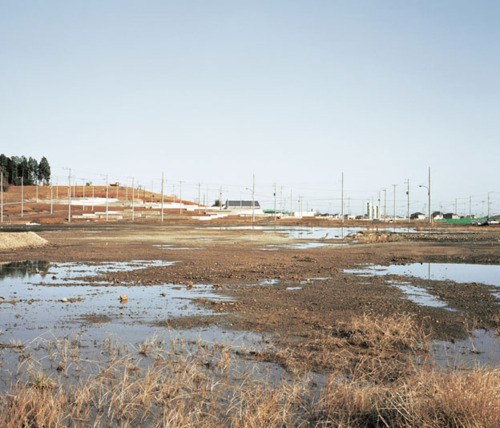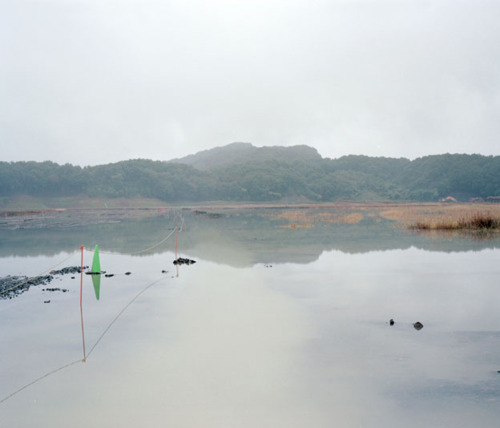It is inevitable that we read your intent as critical when we consider your way of photographing the landscape. Yet your images do not require the violent immediacy of a too explicit grievance, but rather seem to speak in a more intimate language that is still incisive. We could say that these marginal sites with their bleak earthworks, and the traces of human intervention that resemble open wounds left exposed, are representations of an inner world, perhaps contemporary man facing the heavier signs of modernity?
Koichi Nishiyama (KN): Even in Europe and Asia of hundreds of years ago, complicated situations peculiar to those ages and societies must have existed. As I live in contemporary Japan and create works, I cannot be indifferent to various circumstances that exist today in Japan. I try to be conscious of them, but I don’t want to evaluate them nonetheless. I try to be neutral. There are ambiguous aspects in the experiences I have when I encounter certain kinds of landscapes and in the memories I have cherished for a long period of time. I don’t want to give names easily to these ambiguous feelings and memories. Once I give them names, I am afraid, their qualities may change. At the same time, I don’t want to tag them as only something of this age. However, it seems that I cannot keep such solitary and private things as they are. I started to walk around with my camera several years ago. When I take pictures, I feel that I am going a long way around the ambiguousness in the hope that I can reach the core someday.



© Koichi Nishiyama from the series 'Nowhere'
You seem to suggest that absence and emptiness are essential in order to undertake a fruitful discussion, as if to “find ourselves” it is necessary to get rid of everything that continually distracts us, and prevents us from considering our real condition. It also is a sort of self-discipline from a creative standpoint?
KN: Maybe there are too many words and meanings in our daily lives. I don’t shut myself away from the society like a monk and I even have Facebook and Twitter accounts. Living in Tokyo, I am surrounded by various human relationships. However, in those things we call art or photography, we can find a lot of predecessors’ works which still talk a lot out of silence. These works have added very happy moments to my life. Such happiness means to me being true to myself and free from any disguise. For me, art and photography represent one of a few places where I can be honest to myself and let my guard down.


© Koichi Nishiyama from the series 'Nowhere'
Your work is characterized by a great attention to composition and extreme image definition, elements that give your photos an almost painterly appearance. Do you believe that beauty can be found anywhere in the world, often right where it’s unexpected, and that we should learn how to see it?
KN: Artists who take photographs in this age always fight against the sense of already seen. This may be the feeling shared by artists all over the world. When we express something, it is immediately given an index and categorized. While growing up, I have seen much Western and Japanese art as well as many photographs and movies. I have been influenced a lot by them and I know by myself that I live in the continuum of their history. Nonetheless, I hope to be humble and acknowledge that I have not seen the whole world. I don’t know whether everyone should know every corner of the world, but it is an undeniable truth that, even when there are an overflowing number of cameras in this world, there are a lot of things that have not been photographed yet. Regardless of art or photography, I only believe in works coming out of each creator’s innermost motivation. I don’t think that such deepest parts of people have already been wholly uncovered.

© Koichi Nishiyama from the series 'Nowhere'
Landscape photography has entered a very significant period, a new critical consciousness accompanies the research, not merely aesthetic, of many young artists in America and Europe that reaffirms the active role of the medium from a social perspective. In this sense, how do you evaluate the Japanese contemporary scene?
KN: Some Japanese photographers have journalistic points of views and others try to express their inner visions. So many photographers and so many viewpoints, but it seems in general that they are required to reflect something belonging to this age. On the other hand, you can also approach the essence of the inexplicable media called photography by selecting reticent objects such as landscapes. Self-criticism is also valued there in some parts. This approach seems to be disengaged from the society, but it also has social aspects, for it tells us a grandiose story about our society from the 20th century. However, I received this question several months ago, and before responding to it, there have been severe disasters in Japan. We have witnessed landscapes losing their reticence and changing their qualities.These disasters may affect Japanese photographers to face landscapes from different points of view.Increasing number of works may be created on the assumption that we believed we had built a well-off and safe society but actually we are living an uncertain life on a vulnerable land.


© Koichi Nishiyama from the series 'Nowhere'
---
LINKS
Koichi Nishiyama
Japan
share this page